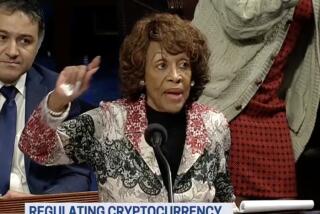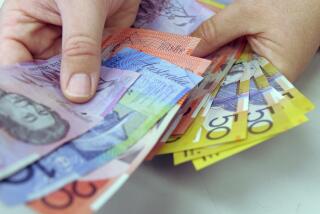COLUMN ONE : U.S. Coins: Time for Change? : Disparate groups want to put a new face on certain denominations. And there is also a movement to get rid of the dollar bill and dump the penny.
In a year when Congress is grappling with severe spending cuts, tax increases and the possibility of a Middle East war, a battle has been raging in Washington over nothing more than small change.
Two disparate groups--one led by a Washington lobbyist, the other by a former U.S. art commissioner--are vying to revamp the nation’s coins. And despite strong opposition from the general public and the Treasury Department, some political pundits believe coins are sure to get a once over, possibly as early as next year.
Why all the fuss about pocket change in a year as busy as 1990? It boils down to economics.
Making money is a money-making issue. Advocates of changing change maintain that the government will save hundreds of millions of dollars annually by simply making a few minor alterations in the nation’s coinage.
Currently, two bills are pending before Congress that would change different aspects of U.S. coins. One bill, which has gained the most support, proposes to simply redesign the backsides of all currently circulating coins.
It would cut the American eagles off the backs of half-dollars and quarters. It would rid the dime of its torch, the nickel of Monticello and the penny of the Lincoln Memorial. Instead, it would back the heads of Kennedy, Washington, Roosevelt, Jefferson and Lincoln with scenes depicting freedoms Americans won with the Bill of Rights. Which five of the 10 rights would be depicted is still a matter of debate.
The other proposal is somewhat more radical. It would get rid of the dollar bill in favor of a dollar coin, and it would foster a study regarding the elimination of the penny.
What’s the point? For coin redesign, the purpose is mainly aesthetic, said Diane Wolf, a former U.S. commissioner of fine arts, who is that bill’s primary advocate. Wolf’s job as arts commissioner included reviewing architectural designs for federal buildings.
“A coin is a piece of sculpture that people hold in their hands each day. They should represent what is important to civilization at any given time,” Wolf said. “Our coins have us stuck in the Great Depression,” she said, noting that the last major redesign of U.S. coins was in the 1930s.
The other bill to create a dollar coin is purely practical, said James C. Benfield, executive director of the Coin Coalition, which represents everyone from vending machine manufacturers to the blind.
“In its simplest form, a coin is good for small transactions and paper is good for large purchases,” Benfield said. “Right now we are using paper for all purposes.”
As inflation drives up prices for everything from parking to candy bars, the need for a larger denomination coin becomes more acute, he adds. Moreover, Benfield says, the short life of a dollar bill calls to mind environmental issues.
“Think of dollar bills as disposables, since they last only about 17 months. Coins are reusables; they last about 30 years,” Benfield said. “You need 20 dollar bills to do the job of one coin.”
Studies by the Treasury Department and the General Accounting Office, the investigative arm of Congress, indicate that both bills would provide much-needed federal revenue.
The coin redesign bill would generate about $250 million in profit over a six-year period, according to Donna Pope, director of the U.S. Mint. (Wolf maintains that the revenue will be four times greater.) And replacing dollar bills with dollar coins would create an average annual profit of $318 million over the next 30 years, according to the GAO.
At issue is mainly what’s called seignorage, which is the difference between what it costs to make a particular coin and its face value. It costs the Mint only 3.2 cents to make a quarter, for example, even though the public pays 25 cents for it. The 21.8-cent difference goes down as a seignorage profit on the government’s books. And considering that the United States makes nearly 1.5 billion quarters each year, that can really add up.
In years when there is a new coin, the U.S. Mint greatly increases its production of coins, according to Wolf. The reason: Collectors squirrel away a large percentage of a new issue, so the government has to produce more just to keep Americans in pocket change.
The catch is that seignorage is a temporary profit. Sooner or later, even coins wear out. They get returned to the Mint, which must pay the bearer face value. That’s “reverse seignorage”--the government must deduct the seignorage profit from its books.
Nevertheless, even temporary profits are helpful in a year of record deficits because they allow the government to forestall some borrowing. That saves on interest charges the United States would otherwise have to pay investors who lend it money by buying Treasury bills, notes and bonds.
If the coin-redesign bill passes, Pope estimates that the interest savings would total about $4 million.
“I don’t want to sneeze at $3 million or $4 million,” Pope said. But she says she’s concerned that Congress will pass the coin-redesign bill on the weight of Wolf’s profit projections, and then be disappointed when those profits don’t pan out.
Moreover, coin experts note, producing coins only proves profitable when people accept them. The public almost always does, but there has been one noteworthy recent exception: the Susan B. Anthony dollar.
When the Mint made 857 million of those coins a decade ago, it declared roughly 97 cents profit on each one. But people wouldn’t use the Anthony coins because they were too frequently confused with quarters.
Although the late suffragette only looks slightly like George Washington, whose image graces the quarter, the size and color of the Anthony dollar is almost identical to the 25-cent piece. And people rarely inspect the faces on their change before they use them.
The Mint pays the Federal Reserve roughly $30,000 annually to store about 425 million Anthony dollars that were never circulated, according to David Carmel, a Mint spokesman. It doesn’t melt them down “because the government would then have to remove the seignorage (profits) from its books,” Carmel said.
Also, the Mint still sends out a few of the unpopular Anthony coins, primarily to rapid transit systems that use them as tokens and to gambling establishments with dollar slot machines.
The Susan B. debacle is, in fact, one of the main stumbling blocks when it comes to issuing new coins. Pope points to it as a graphic example of what can happen when the public isn’t ready for a change. And Congress is weighing it heavily when it considers the dollar-coin bill.
Dollar-coin advocate Benfield, however, said the Susan B. problem would be avoided under the current legislation because the new coin would be copper-colored to avoid confusion with the quarter. Moreover, the new law would require dollar bills to be taken out of circulation, which would give the public little choice about whether to use the coin.
But objections to both bills is broader. Opposition starts with the Treasury--which doesn’t think a change is needed--and extends to the rank-and-file American.
A Denver Post survey, for example, indicated that 83% of those questioned didn’t want their coins redesigned. Similar studies have indicated that dollar coins are also unpopular.
The Gallup Organization studied American attitudes toward getting rid of the penny. Even though many Americans find the cent a nuisance, 67% of those surveyed were opposed to eliminating it.
Additionally, one economist recently told Congress that dumping the penny would cost consumers $600 million annually. That’s because businesses would round prices up to the next nickel, thus charging a few cents more for nearly every purchase.
Meanwhile, the nation’s banking industry is actively fighting the dollar-coin bill, contending that any money saved by the U.S. government would be offset by added costs paid by private industry and passed on to the public.
“I understand there is a savings to the federal government. But that savings is going to have to come from somewhere,” said Larry Kurmel, executive director of the California Bankers Assn. in San Francisco. “Who do you think is going to have to pay it?”
The costs passed on to the public would come in a variety of forms, Kurmel said. Dollar coins would be heavier and harder to process through banks, he noted. They would take up more space in cash drawers and vaults, increasing storage costs. And guards and bank tellers who handle heavy sacks of the coins would likely suffer more work-related injuries, he said.
Meanwhile, retailers would have to get new drawers for their cash registers to accommodate the extra coin. And any business that uses a change counter would have to get a new machine, since change counters don’t currently count dollar coins. All these expenses would be passed on to the public in higher prices, Kurmel maintains.
However, some rapid transit systems say a dollar coin would save them money because they’d no longer need to count dollar bills.
“It costs us 3 cents per bill to pay a contractor to take our dollar bills and make them into packages the banks will accept,” said Thomas Rubin, chief financial officer of the Los Angeles Rapid Transit District. “That amounts to about $3 million a year. Coins are much easier to process.”
How will this all shake out? Like much of what happens in Washington, experts believe that both advocates and foes of changing change will win a little and lose a little. Although the chances of the dollar-coin bill passing this year seem slim, Congress is likely to allow for the redesign of at least some coins, according to a staffer at the House Consumer Affairs subcommittee. The Senate has already approved coin redesign, but the House has yet to take action.
One compromise that seems amenable to both the Mint and some of the bill’s congressional opponents is issuing one redesigned coin and then waiting for the public reaction. If Americans don’t mind the change, the government would probably redesign more coins, Pope said.
“I don’t think there is any business in America that would put out a new product without doing some market research first,” Pope added.
More to Read
Sign up for Essential California
The most important California stories and recommendations in your inbox every morning.
You may occasionally receive promotional content from the Los Angeles Times.










